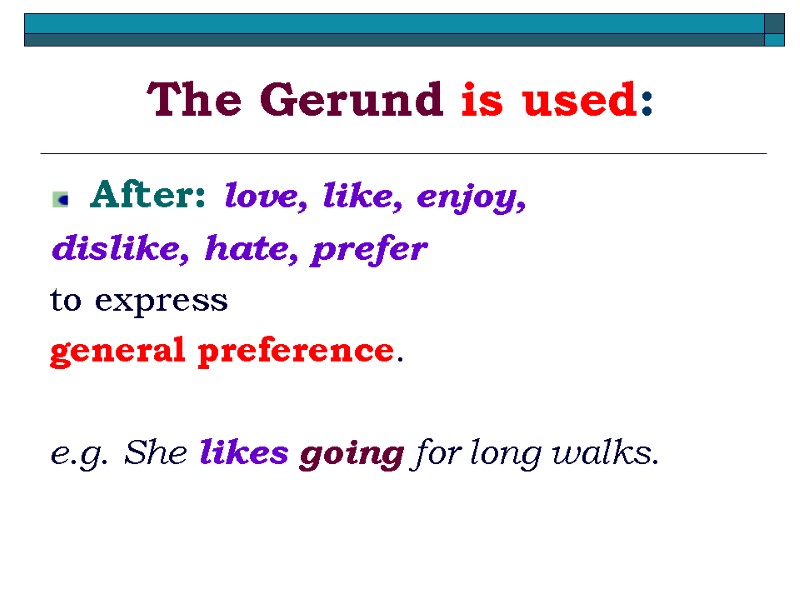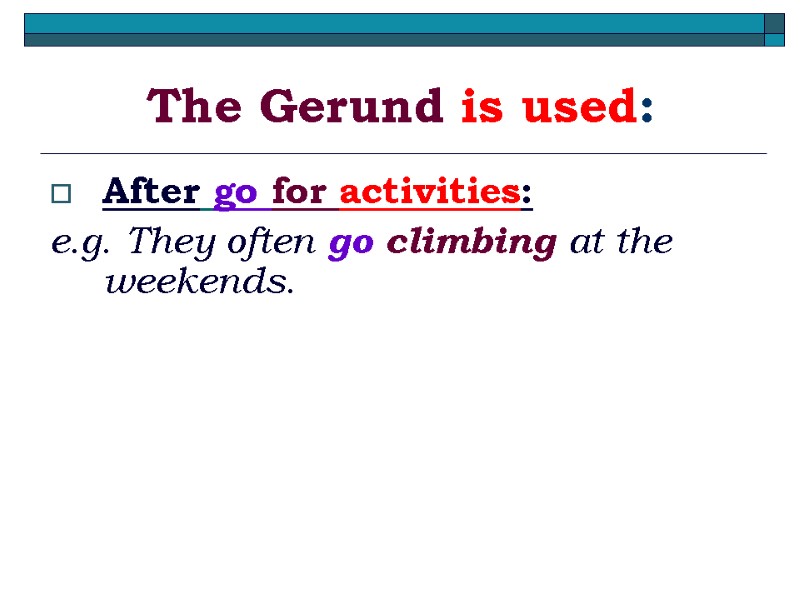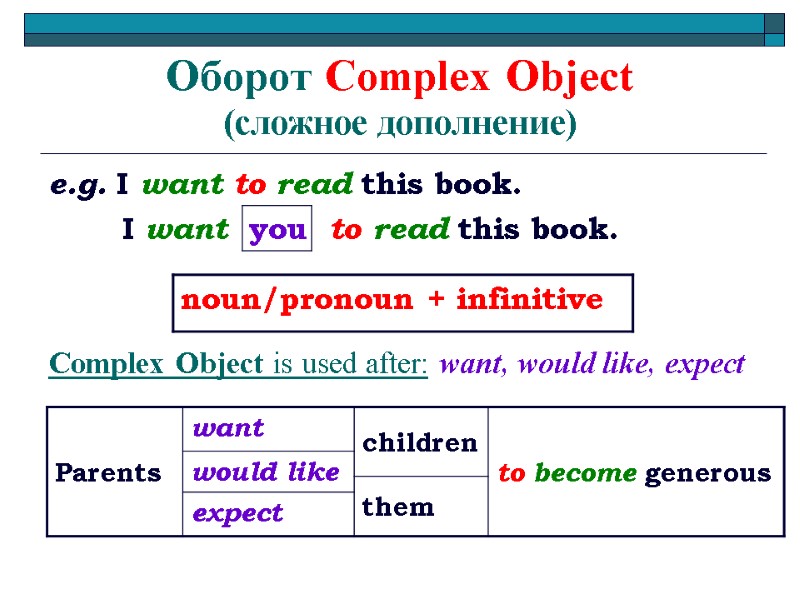GRAMMAR & VOCABULARY VERBALS (неличные формы глагола) VERBALS


GRAMMAR & VOCABULARY VERBALS (неличные формы глагола)

VERBALS (неличные формы глагола) The Infinitive The Gerund The Participle

VERBALS (неличные формы глагола) The Infinitive “To be or not to be, that is the question”. (W.Shakespeare) The Gerund “The best part of living is loving & giving” The Participle “Lose an hour in the morning, and you will spend all day looking for it” “Lost time is never found again”

VERBALS (неличные формы глагола) The Infinitive e.g. Alison likes to read. The Gerund e.g. Alison likes reading. The Participle e.g. The girl reading a book is Alison. The book read by Alison is very interesting. Having read the book, Alison went for a walk.

Герундий The Gerund Герундий – это неличная форма глагола, имеющая грамматические особенности как глагола, так и существительного и всегда выражающая действие как ПРОЦЕСС. e.g. I enjoy reading.

The Gerund is used: As a noun e.g. Swimming keeps you fit.

The Gerund is used: After: love, like, enjoy, dislike, hate, prefer to express general preference. e.g. She likes going for long walks.

The Gerund is used: After go for activities: e.g. They often go climbing at the weekends.

The Gerund is used: After prepositions: e.g. He left without saying goodbye.

The Gerund is used: The Gerund is used: After certain verbs: admit, avoid, consider, deny, fancy, imagine, involve, look forward to, mind, mention, regret, risk, spend, suggest, etc. e.g. Jessica spent all day shopping.

The Gerund is used: The Gerund is used: After: be busy, it’s no use/good, it’s (not) worth, what’s the use of…?, can’t help, there’s no point (in), can’t stand, have difficulty (in), have trouble, have a hard/difficult time,be/get used to, e.g. It’s no use waiting for the bus. It won’t come.

The Gerund is used: After the verbs: see, hear, feel, watch, listen to, notice to describe an incomplete action, that is to say that smb. saw, heard, etc. only a part of the action. e.g. I heard Jack talking on the phone. (= I heard Jack while he was talking on the phone. I heard part of the action in progress. I didn’t listen to the whole conversation.) Compare: e.g. I heard Jack talk on the phone. (= I heard the whole conversation from beginning to end).

The Infinitive the to infinitive e.g. I hope to see you soon. the bare infinitive e.g. He can’t help you.

The to infinitive is used: To express purpose – e.g. She went to the bank to get some money. After certain verbs (advise, agree, appear, decide, expect, hope, manage, offer, promise, refuse, seem, want, afford, pretend, etc.) – e.g. He advised me to apply for the job.

The to infinitive is used: after verbs such as know, decide, ask, learn, want to know, remember, etc. when they are followed by question words (who, what, how, where, etc.). ‘Why’ is followed by a subject + V, not by an infinitive. e.g. I can’t decide where to go. I want to know why you have left the room.

The to infinitive is used: After adjectives: nice, sorry, glad, happy, willing, afraid, ashamed, etc. e.g. He is glad to be back. After too & enough e.g. She is too shy to talk to the manager. We’ve got enough money to buy a new car.

The to infinitive is used: After: it + be + adjective (+of +noun/pronoun) e.g. It was nice of him to help. After: would like/ would love/ would prefer (to express specific preference) e.g. I would like to learn a foreign language. After: only to express an unsatisfactory result e.g. He rushed to the back door only to discover that it was locked.

Оборот Complex Object (сложное дополнение) e.g. I want to read this book. I want you to read this book. Complex Object is used after: want, would like, expect

The bare infinitive is used: After modal verbs (may, should, can, must, etc.) e.g. You must study hard. After the verbs let, make, see, hear & feel (см. Complex Object # ) BUT! be made/be heard/be seen + to-infinitive (passive) e.g. He was made to pay for the damage.

The bare infinitive is used: After had better, would rather e.g. You had better sign the contract. You would rather go home now.
10516-the_gerund.ppt
- Количество слайдов: 20

